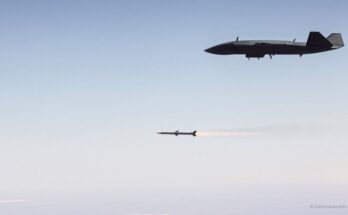
When is a monopoly not a monopoly? When it is a joint venture – until it’s not.
Sonobuoy manufacturer ERAPSCO (a joint venture between Sparton and Ultra Maritime) announced on its website that it will be dissolved as of September 30. The two companies will continue to produce sonobuoys individually under their own names.
ERAPSCO will continue fulfilling existing contracts through the end of 2023.
Sparton and Ultra Maritime (part of Ultra Group, once more commonly known as Ultra Electronics) have produced sonobuoys for the U.S. Navy in this joint venture for over 35 years. Another joint venture between the two, Sonobuoy TechSystems (STS), which produces another model of sonobuoys, will also be disbanded.
Rumors of the decision to dissolve the joint venture date back to at least February 2022, when Sparton president and CEO Tracy Howard said that big changes lay ahead.
The Sparton/Ultra sonobuoy demi-monopoly goes way back. In December 1995, Hughes bought Magnavox Electronic Systems and integrated it into Hughes Defense and Communications Systems. This was followed by Raytheon’s acquisition of Hughes, which manufactured sonobuoys such as the SSQ-62(V) under the Raytheon name.
In late 1998, the U.K.-based aerospace and defense electronics company Ultra Electronics acquired Raytheon’s sonobuoy product line. This acquisition (coupled with its previous buyout of Hermes in Canada) in a defense industry full of takeovers and mergers offered Ultra Electronics significant capability for expansion into the North American (specifically U.S.) sonobuoy market.
In February 2007, Sparton and Ultra announced a broadening of the scope of the existing joint venture agreement between their respective subsidiaries, Undersea Sensor Systems Inc (USSI) of Columbia City, Indiana, and Sparton Electronics Florida Inc. Under the plan, ERAPSCO, which had focused solely on the SSQ-101, would now encompass a broader range of sonobuoy types qualified for use by the U.S. Navy and procurement by international customers. ERAPSCO has been developing products for the U.S. Navy since 1987. Sonobuoy TechSystems (STS) operates under ERAPSCO for all ITAR (International Traffic in Arms Regulations)-approved international sales and provides technical support of U.S.-specification sonobuoys.
In early 2018, the U.S. Department of Justice (DoJ) put the kibosh on Ultra Electronics’ $234 million acquisition of Sparton. According to the DoJ, the merger would have created a monopolistic supplier of sonobuoy systems to the U.S. Navy.
The ruling went even further – opening an investigation of the two companies’ sonobuoy joint venture, ERAPSCO, which they formed in 1987. (Ideally, the DoJ wanted to see the companies build up their own individual abilities to produce sonobuoys, eventually dissolving the ERAPSCO joint venture.)
Apparently, the U.S. Navy became tired of dealing with the same two sonobuoy makers, Sparton and Ultra Electronics. In a January 2014 solicitation for the Coherent Source Sonobuoy project, the U.S. Navy announced it was searching for other manufacturers. However, while other companies can make sonobuoys – probably very good ones – they would be priced much higher than those produced by Sparton and Ultra, which owe much of their control of market share to pricing as well as product quality.
In theory, there is supposed to be a competitive bidding process in the United States to avoid giving one company a monopoly. However, in the sonobuoy industry as in the shipbuilding industry, when there are only two major manufacturers in a competition, each one tends to get a piece of a contract in order to keep the production line and facilities viable. This doesn’t always work well for the consumer – in this case the American taxpayer.
Along these lines, the U.S. Navy tried to block Sparton (one half of ERAPSCO, the other half being Ultra Electronics) from bidding on the next-generation variant, the SSQ-125A; however, Sparton filed a protest and won.
The U.S. Navy had to reverse its decision and in December 2018 awarded ERAPSCO half of the SSQ-125A production contract for 18,000 SSQ-125A sonobuoys worth up to a combined $220.8 million.
This was then followed up with supplemental contracts awarded to ERAPSCO: one in July 2020 and another in March 2021.
The other half went to Lockheed Martin (possibly to make the contract look competitive), which had entered the A-size sonobuoy market thanks to its expertise in making A-size autonomous underwater vehicles (AUVs) that can be launched from the same canisters as the SSQ-125(V) sonobuoys.
Sparton anticipated that should the U.S. Navy push for the dissolution of the ERAPSCO joint venture, the service would, in turn, assist in funding the company’s transition to independently developing, producing, and selling sonobuoys. Again, however, as evidenced by the shipbuilding industry, when there are only two manufacturers, each one tends to get a piece of a contract to keep the production lines and facilities viable.
Despite these misgivings from the service, ERAPSCO scored a major sonobuoy contract in July 2019 when the Navy purchased 37,500 sonobuoys of various types for some $1 billion. These systems are being delivered through 2023 and are aimed at dealing with increased production of submarines by China and undersea warfare activity in the South China Sea, as well as Russia’s not-so-subtle plans for the Arctic.
After the failure of the earlier merger attempt to combine Sparton with Ultra Electronics, a new suitor swept in and bought Sparton. This time it was a private equity firm, Cerberus Capital Management. In March 2019, Cerberus successfully acquired Sparton for $181.5 million.
However, the Cerberus acquisition wasn’t for long, as Sparton was promptly sold again. This time it appeared that Sparton may had found its forever home with the announcement that it would be acquired by Elbit Systems of Israel in a $380 million deal in December 2020. This was the latest in a series of merger and acquisition moves undertaken in the past few years.
At the time, the acquisition by Elbit Systems was thought to be a step in the right direction – which it apparently was, albeit a few years later.
Forecast International’s Anti-Submarine Warfare Forecast covers the technologies being developed and produced to counter the submarine threat. This service contains reports on leading programs such as the DICASS sonobuoy, the Mk 48 ADCAP torpedo, the NAUTIS family of C2 systems, the Enhanced Polar System (EPS), and Surface Ship Torpedo Defense (SSTD) weapons. Also featured are promising developments such as air-independent propulsion for diesel-electric submarines, new silencing techniques, and the widespread introduction of unmanned underwater vehicles that could assume some of the hazardous duties now performed by manned submarines.
For more than 30 years, Richard has performed numerous roles as a top analyst for Forecast International. Currently, Richard is the Group Leader and Lead Analyst for Forecast International's Traditional Defense Systems, which covers all aspects of naval warfare, military vehicles, ordnance and munitions, missiles, and unmanned vehicles.
Having previously been Forecast International's Electronics Group Leader for 20-plus years, Richard established Electro-Optical Systems Forecast, as well as having been the prime editor of Electronic Systems Forecast, Land & Sea-Based Electronics Forecast, and C4I Forecast. Additionally, Richard has served as the Naval Systems Group Leader responsible for Anti-Submarine Warfare Forecast andWarships Forecast.



